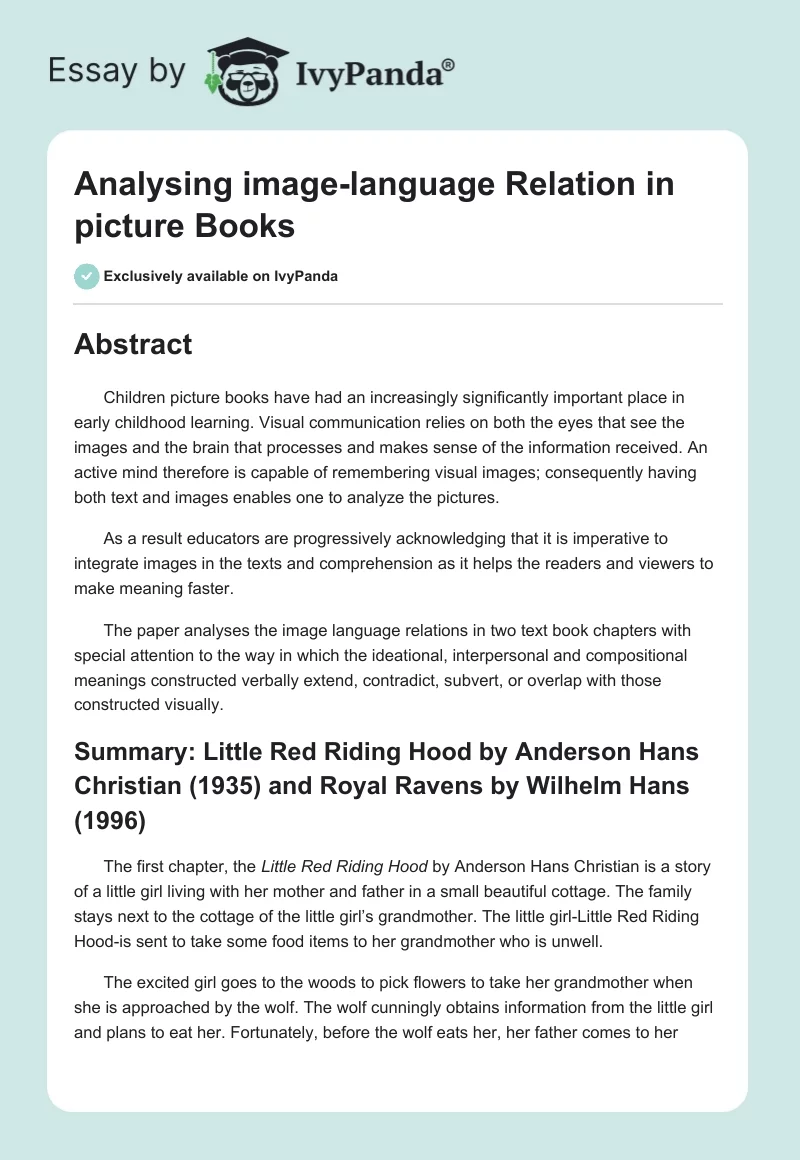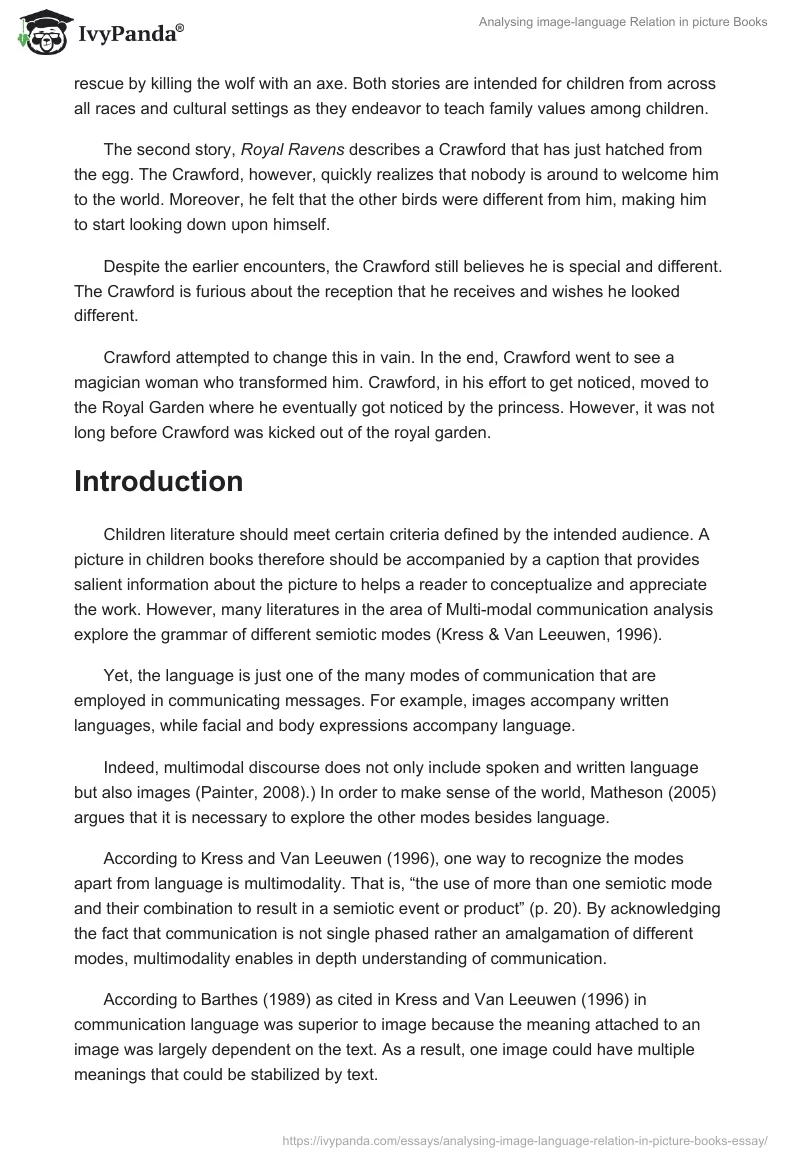Abstract
Children picture books have had an increasingly significantly important place in early childhood learning. Visual communication relies on both the eyes that see the images and the brain that processes and makes sense of the information received. An active mind therefore is capable of remembering visual images; consequently having both text and images enables one to analyze the pictures.
As a result educators are progressively acknowledging that it is imperative to integrate images in the texts and comprehension as it helps the readers and viewers to make meaning faster.
The paper analyses the image language relations in two text book chapters with special attention to the way in which the ideational, interpersonal and compositional meanings constructed verbally extend, contradict, subvert, or overlap with those constructed visually.
Summary: Little Red Riding Hood by Anderson Hans Christian (1935) and Royal Ravens by Wilhelm Hans (1996)
The first chapter, the Little Red Riding Hood by Anderson Hans Christian is a story of a little girl living with her mother and father in a small beautiful cottage. The family stays next to the cottage of the little girl’s grandmother. The little girl-Little Red Riding Hood-is sent to take some food items to her grandmother who is unwell.
The excited girl goes to the woods to pick flowers to take her grandmother when she is approached by the wolf. The wolf cunningly obtains information from the little girl and plans to eat her. Fortunately, before the wolf eats her, her father comes to her rescue by killing the wolf with an axe. Both stories are intended for children from across all races and cultural settings as they endeavor to teach family values among children.
The second story, Royal Ravens describes a Crawford that has just hatched from the egg. The Crawford, however, quickly realizes that nobody is around to welcome him to the world. Moreover, he felt that the other birds were different from him, making him to start looking down upon himself.
Despite the earlier encounters, the Crawford still believes he is special and different. The Crawford is furious about the reception that he receives and wishes he looked different.
Crawford attempted to change this in vain. In the end, Crawford went to see a magician woman who transformed him. Crawford, in his effort to get noticed, moved to the Royal Garden where he eventually got noticed by the princess. However, it was not long before Crawford was kicked out of the royal garden.
Introduction
Children literature should meet certain criteria defined by the intended audience. A picture in children books therefore should be accompanied by a caption that provides salient information about the picture to helps a reader to conceptualize and appreciate the work. However, many literatures in the area of Multi-modal communication analysis explore the grammar of different semiotic modes (Kress & Van Leeuwen, 1996).
Yet, the language is just one of the many modes of communication that are employed in communicating messages. For example, images accompany written languages, while facial and body expressions accompany language.
Indeed, multimodal discourse does not only include spoken and written language but also images (Painter, 2008).) In order to make sense of the world, Matheson (2005) argues that it is necessary to explore the other modes besides language.
According to Kress and Van Leeuwen (1996), one way to recognize the modes apart from language is multimodality. That is, “the use of more than one semiotic mode and their combination to result in a semiotic event or product” (p. 20). By acknowledging the fact that communication is not single phased rather an amalgamation of different modes, multimodality enables in depth understanding of communication.
According to Barthes (1989) as cited in Kress and Van Leeuwen (1996) in communication language was superior to image because the meaning attached to an image was largely dependent on the text. As a result, one image could have multiple meanings that could be stabilized by text.
Therefore, “…literacy pedagogy can no longer be confined to realm of language alone…but should account for the role of images as well other modes.” (Unsworth, 2006 p. 55)
Analysing Image Language Relations in Picture Books
The story Little Red Riding Hood by Anderson Hans Christian’s presentation characteristically combines the use of both image and text relying on the exchange of meanings between the two. According to Meek (1998) as cited in (Matheson, 2005), children’s picture books are significant educational texts as they provide the children with implicit and explicit literacy lessons.
Furthermore, such books are powerful ideological tools that can be employed in challenging popular social values about home, school, childhood, and family. According to Nodelman (1998), picture book stories can never be understood by reading the words or viewing the pictures alone, but meanings emerges out of the mutual inter animation of the two.
Thus, the pictures and words must be viewed and read concurrently in order to achieve a whole experience with picture books. In fact, the communication of visual information and ideas for the last four centuries has been the function that has enabled science to advance, has it has helped people to see how things work.
Therefore, following Barthes (1989) as cited in Kress and Van Leeuwen (1996), it can be said that the language used makes the images more specific.
The images in the story deal with factors that language is clearly ill equipped to handle, to be precise the visually salient elements of their subjects and of their spatial relations with each other (Kress & Van Leeuwen, 1996). A picture still can also invoke meanings by adding information to the words presented, for example, the story teaches on family values of care, protection and love for family members.
At the onset the viewers or readers of the story are introduced to the family of a sweet little maid living in a pretty little cottage not so far from her grandmother’s home. Onwards, family love is discussed and the acts expression of love is depicted by the gifts that receive from family members.
Figure 1.1: Little Red Riding Hood and her mother outside their cottage
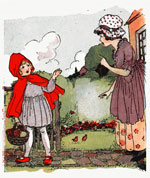
Efforts by adults and the society in general to instil particular codes of behaviour and value systems in children have been an integral part of community life and parenting. Moreover, educational institutions and religious organizations, too, have long professed the advantages of such training from an early age (Unsworth, 2001).
Further on the Little Red Riding Hood is set off to go visit the grandmother who had been feeling unwell. Family values are further enhanced in the child by the love and care that her mother extends to the grandmother. The little girl even stops over the woods to pick her favourite flowers to take to her grandmother (See figure 1.2).
Figure: 1.2 Little Red Riding Hood picking flowers for her ill grandmother
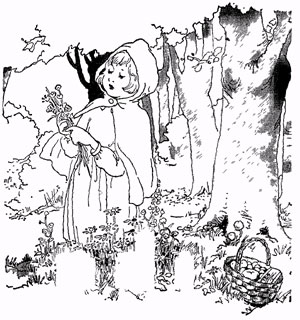
Note the basket full of items given by her mother to take to her grandmother.
Visual representational meaning of the stories conveys the relationship between the participants and the depicted structuring. The creation of a visual representational meaning proposed the space-based model for analysis centered in the placement of objects within the semiotic space (Jewitt & Oyama, 2001).
However, there has been contention on the harmonious co-existent between the text and the image has been brought by different commentators, still, the images above contents that outside the resistance-compliance question raised by other commentators, their exist a verifiable cosy relationship between the photo and the text.
According to Kress and Van Leeuwen (1996), the relationship between the visual participants-interactive or represented- in each particular image is realized by elements defined as vectors or processes which correspond to a group of action verbs.
In the two stories, the ‘vectorial’ relations are represented narrative process that according to Jewitt and Oyama (2001), serve to depict the participants in action movement, in terms of dynamic “doings” and “happenings” (p. 141).
Furthermore, the narrative processes “…present unfolding actions and events, processes of change, transitory spatial arrangements” (Kress & Van Leeuwen, 1996 p. 56).
Moreover, visual analysis of the images presented in the story can be achieved through conceptual processes that are visually characterized by the absence of vectors (Jewitt & Oyama, 2001). They argue that these conceptual processes define, analyze and classify places, people or things including abstract ones.
These processes can be classified into Classificational, Symbolic, and Analytical. Kress and Van Leeuwen (1996) state that the Classificational categorizes people, things or places in a tree structure in which things are represented as belonging to a particular class or order.
In the story conceptual processes occur when the little girl encounters a cunning wolf that after some interaction with the girl goes ahead to the grandmother’s cottage to wait for her there. The wolf is shown opening the door of the Little Red Riding Hood’s grandmother’s house after mimicking the little girl’s voice.
The presentation of the wolf in the story is presented as a new item to the audience so that it has the potential attract attention because it presents problematic and contestable information, as such the audience must pay special attention. For example, the viewers or readers will take keen interest on a wolf that can talk and act like a human character. See Figure 1.3 and 1.4
Figure: 1.3 The wolf opening grandmother’s Cottage
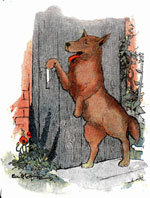
Figure: 1.4 The wolf’s head is axed
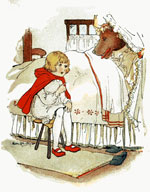
Finally, the father who was passing by heard the screams of her daughter and rushed in axing the wolf’s head. This event further illustrates the intent of the story to instil family values on children.
According to Kress and Leeuwen (1996), there are three kinds of meanings that are concerned with building relationships between the reader or viewer and the text: those of (1) attitude, (2) social distance, and (3) contact. Contact is one of the most important visual systems as it enables the viewer or reader to distinguish between images that depict different objects, such as person or animal.
Contact visualization is commonly achieved by use text that introduces the characters at the beginning of the story. The first story the Royal Ravens focuses on the aspect of childhood development of from the perspective of a Crawford.
In the family context the book shows two families: one, family where almost everybody is left to fend for himself/herself like the case of the Crawford that hatches from the egg alone and none of the other birds even show any little concern for the Crawford’s arrival into the world. This is typical of life of animals in the jungle.
On the other extreme end, the book presents a second family that is responsible for its members even having a princess and with a family where the crow is taken into for some time. However, from the story and the pictures, this family everybody is held accountable for their actions and when the Crawford messes up during a family dinner he is kicked out of the home.
Furthermore, the story also creates what Kress and Van Leeuwen (1996) refer to as attitude. Attitude, according these authors, relates to the way the viewer or reader relates to images in either horizontal or vertical angle. As Kress and Van Leeuwen (1996) argue, the reader or viewers look from a vertical angle to depict power relations.
For example, when the reader or viewer looks up from a low angle, they show authority. On the other hand, when the viewer looks down from a high angle, they show vulnerability. In the story Royal Ravens, the author indicates that after the Crawford had been banished to a huge golden cave, he looked sad and yearned for freedom. The picture presented by the author of the Crawford as he is being led to the cage shows vulnerability.
In addition, in the story the Royal Raven, the contact image and social relations between humans and animals is depicted in the shifts in roles of the Crawford that makes the viewer to feel sympathy for him. An example occurs when the Crawford is caged in the royal garden and the Crawford had to literally pluck out its feathers in order to attain his freedom.
Despite having abandoned his family for the Royal family, the Crawford is welcomed back even with no feathers on his body. It shows that family is highly valued in both worlds even though at times in the jungle, they might not openly show it.
On the other hand, value for family is indicated by the way they princess react when the Crawford messes during a family dinner. The princess realizes that family comes first and cages the Crawford in spite of his beauty.
The meanings expressed by humans through visual forms have been conceived to have no literal equivalent in any other form of human communication. Both Arnheim (1969) and Goodman (1968) proposed that it is not possible to transfer thought from one form to another without distortion. According to them, visual and verbal thinking are equal but separate.
In a sense, the viewer’s evaluation of the images is facilitated by the far social distance from which they are depicted. Such a distance consists of a level of visual perception between the total intimacy promoted by a close-up shot and the complete detachment promoted by a long one.
From a far social distance, the viewer’s judgment about the represented participant has ‘a more formal and impersonal character than that in the close phase’ (Kress & Van Leeuwen, 1996 p.113).
In conclusion, besides the language used in communication, in the contemporary society, images also form an important mode of communication. The images offer a reader or viewers with domain of human experience that was both a unique way of knowing and containing a unique content.
The stories have achieved their intended purpose of not only instilling family values such as sharing and love in children, but also acting as a deterrence to children who might wonder or interact with strangers. They are taught to keep family secrets to only family members and never to share it with strangers.
Table 1: Royal Ravens by Wilhelm Hans (1996).
Table 2: Little Red Riding Hood by Anderson Hans Christian (1935)
References
Arnheim, R. (1969). Visual Thinking. Berkeley: University of California Press.
Goodman, N. (1968). Languages of Art: an approach to a Theory of Symbols. Indianapolis: Bobbs- Merrill.
Jewitt, C., & Oyama, R. (2001). Visual Meaning: A Social Semiotic Approach in Handbook of Visual Analysis. London: Sage.
Kress, G., & Van Leeuwen, T. (1996). Reading Images: The Grammar of Visual Design. London: Routledge.
Matheson, D. (2005). Media Discourses: Issues in Cultural and Media Studies.
Maidenhead: Open University Press.
Nodelman, P. (1988). Words about Pictures. Athens: The University of Georgia Press.
Painter, C. (2008). The Role of Color in Children’s Picture Books: Choices in Ambience. In L. Unsworth (Ed.), New Literacies and the English Curriculum (pp. 89-111). London: Continuum.
Unsworth, L. (2001). Describing Visual Literacies in Teaching Multiliteracies: Changing Contexts of Texts and Images in Classroom Practice. Buckingham: Open University Press.

